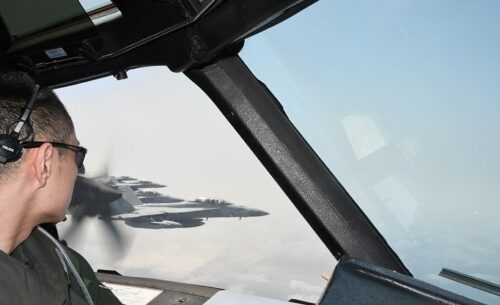The U.S. Navy’s expeditionary Electronic Attack Squadron (VAQ) 131, operating under Task Force 70, conducted a bilateral electronic warfare exercise with the Japan Maritime Self-Defense Force (JMSDF) on Apr. 3, south of Okinawa, Japan.

The bilateral training marks the first significant operational implementation of the FUJIN memorandum of understanding signed between the two naval forces in December 2024.
“This exercise is precisely the tactical integration Vice Adm. Kaneshima and I envisioned when we signed this memorandum,” said U.S. Navy Rear Adm. Greg Newkirk, Commander, Task Force 70. “Our naval air forces are making deep inroads in all-spectrum interoperability, taking a strong unified team and becoming stronger.”
The FUJIN memorandum, named after a Japanese wind deity, was formally signed on Dec. 6, 2024, at Naval Air Facility Atsugi in Kanagawa prefecture. The agreement between JMSDF Vice Adm. Koji Kaneshima, Commander, Fleet Air Force, and Rear Adm. Newkirk established a framework to increase bilateral operations between the forces’ electronic attack squadrons.
“Through our Fujin pact, we have developed and strengthened our electromagnetic warfare capability, as well as the information warfare collaboration between the JMSDF and U.S. Navy,” said Vice Adm. Kaneshima. “We will continue to seek further opportunities to make us stronger and more confident together.”
The April exercise involved VAQ-131 operating EA-18G Growler aircraft alongside JMSDF forces, including the Murasame-class destroyer JS Inazuma (DD-105), EP-3 and OP-3C reconnaissance aircraft, and UP-3D electronic attack aircraft.
VAQ-131 operates from Misawa Air Base in northern Japan and Kadena Air Base in Okinawa. The squadron is one of several U.S. electronic warfare units deployed to Japan, including VAQ-141, which is forward-deployed to Marine Corps Air Station Iwakuni as part of Carrier Air Wing 5, and other expeditionary squadrons that rotate from Whidbey Island, Washington.
“This exercise enhances our combined capability to build, share, and protect battlespace awareness, tying together data from both the air and the sea,” said Cmdr. James Jordan, commanding officer of VAQ-131. “In a crisis, it will be crucial for us to be able to integrate seamlessly with our Japanese allies in the electronic warfare arena.”
The joint training represents a significant step in implementing the broader goals outlined in the December memorandum, which Vice Adm. Kaneshima described as “strengthening Integrated Fire capabilities between CFAF and CTF70.”
At the signing ceremony last December, Rear Adm. Newkirk emphasized that the agreement would “generate real warfighting advantage by increasing and enhancing our combined technology and expertise in the field of electronic warfare.”
Task Force 70 controls the majority of forward-deployed air and surface forces in the U.S. 7th Fleet area of operations. This includes Destroyer Squadron 15, Helicopter Maritime Strike Squadron 51, and the ships and aircraft operating under Carrier Strike Group 5, including the USS George Washington carrier strike group.
For more information, hit the Source below